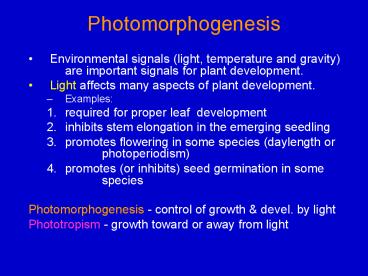Photomorphogenesis - PowerPoint PPT Presentation
1 / 27
Title: Photomorphogenesis
1
Photomorphogenesis
- Environmental signals (light, temperature and
gravity) are important signals for plant
development. - Light affects many aspects of plant development.
- Examples
- required for proper leaf development
- inhibits stem elongation in the emerging seedling
- promotes flowering in some species (daylength or
photoperiodism) - promotes (or inhibits) seed germination in some
species - Photomorphogenesis - control of growth devel.
by light - Phototropism - growth toward or away from light
2
MOLECULAR BIOLOGY OF LEAF DEVELOPMENT
- Leaf development is light-dependent in
angiosperms - Chloroplast development is the signature feature
of leaf development - Proplastids gt (Etioplasts) gt Chloroplasts
- plastid number per cell also increases
- Light controls expression of important
chloroplast proteins
3
Arabidopsis
Dark-grown
Light-grown
cotyledon
hypocotyl
4
Skotomorphogenesis seedling development in
darkness (i.e., elongated shoot (long
hypocotyl), little or no cotyledons or true
leaves)
5
Barley (Hordeum vulgare) 7-10 days old
Older cells (etioplasts)
Young (meristematic) cells w/proplastids
6
- Etioplasts lack
- Chlorophyll
- Photosynthetic capacity
- Major thylakoid membrane proteins
light
Etioplast
Chloroplast
7
CF1- ?,? subunits of ATP synthetase (coupling
factor 1) PSI - photosystem I Chl-apoproteins PSI
I photosystem II Chl-apoproteins Pchlrd
protochlorophyllide reductase LHCII-
light-harvesting Chl-apoproteins of PSII LS -
large subunit of RuBPCase SS small subunit of
RuBPCase
8
Angiosperms require light to make chlorophyll.
several steps
more steps Aminolevulinic acid
--------------gt Mg-Protoporphryin IX
--------------gt light NADPH
Protochlorophyllide --------------------gt
Chlorophyllide -----gt Chlorophyll Pchlrd
Step in chlorophyll synthesis that requires light
Pchlrd (Protochlorophyllide reductase) enzyme
that catalyzes the reduction of
protochlorophyllide it over-accumulates in
dark-grown plants, and is down-regulated by light.
9
Protein synthesis by plastids isolated from
dark-grown barley and after periods of
illumination.
D psbA gene product other proteins are
described in preceding slide
10
Levels of mRNAs for some chloroplast-encoded
proteins in dark-grown barley seedlings and after
1 hour of light.
11
Regulation of Chloroplast-Encoded Proteins
- Result 1 - Based on pulse-labeling of isolated
plastids, synthesis of the major thylakoid
proteins is rapidly induced by light. - Result 2 - Levels of mRNAs for several of these
proteins are already abundant in dark-grown
plants (on a per plastid basis), and do not
change during the early hours of light treatment. - Conclusion light induction of these
chloroplast-encoded proteins is mainly at the
translational or post-translational (i.e.,
protein stability) level.
12
How to distinguish between translational
repression (in the dark) versus rapid degradation
of new apoproteins?
- Experimental data indicates that
- - mRNA for PSI and PSII proteins is on polysomes
in the dark (suggest at least some mRNA being
translated in the dark) - If chlorophyllide is added to plastids from
dark-grown plants, then see greater
pulse-labeling of the PSI and PSII proteins - Conclusion induction is due, at least in part,
to stabilization of newly synthesized
Chl-apoproteins by chlorophyll
13
Nuclear-encoded CabII/lhcII mRNAs are not present
in dark-grown plants. They are induced by white
light or pulses of red light, inhibited by
pulses of far-red light.
14
Transcription run-off in isolated nuclei of
selected genes from dark-grown barley, and after
the indicated light treatments.
rbcS small subunit of RuBPCase cab/lhc
light-harvesting Chl- apoproteins of PSII pcr-
protochlorophyliide reductase
15
Regulation of Nuclear-Encoded Chloroplast Protein
Genes by Light (in Dark-Grown Plants)
- rbcS, cab/lhc, and pcr genes regulated mainly by
transcription - No cab/lhc mRNA in dark-grown plants
- Light can down-regulate genes (pcr) as well as
turn them on - Transcriptional control of these genes mediated
by the photoreceptor Phytochrome
16
How does light control leaf plastid
development?
- 3 parts to this regulatory system
- photoreceptor(s)
- signal transduction chain (2nd messengers?)
- molecular responses (gene activation or
de-repression)
17
(No Transcript)
18
(No Transcript)
19
PHOTORECEPTORS
- Phytochrome (red/far-red)
- Blue/UV receptor (cryptochrome phototropin)
- PHYTOCHROME (PHY)
- Some major phytochrome-controlled processes
- Surface seed germination
- Inhibition of stem elongation in young seedlings
- Promotes leaf development
- Promotes stomatal opening
- Involved in circadian rhythms
20
Phy exists in two interconvertible forms.
Pr - inactive, absorbs mainly red light (660
nm) Pfr - active, absorbs far-red light (730 nm)
Pfr ? Pr slowly in dark
21
- Phytochrome properties
- Protein subunit of 125,000 Daltons (1100 a.a.)
- Chromophore is a linear tetrapyrrole, attached
covalently to a cysteine - Native Phy is a dimer
- Kinase activity
22
- Many Phy-controlled processes are promoted by red
light, inhibited by far-red light - Red-Far Red Test
- Pulse of red light ? response
- Pulse of far-red light ? no response
- Pulse of red light ?pulse of far-red ???
23
Phytochrome
- Multiple Phy genes (5 in Arabidopsis)
- Have overlapping functions, based on mutant
analysis - Also vary with respect to the light intensity or
light quality required for activation - Low fluence (LF) responses
- Very low fluence (VLF) response
- Far-red responses (Phy A)
- Can form heterodimers
24
Blue-UV receptors (for leaf development)
- Absorb in the 350-450 nm range
- Sometimes called Cryptochrome
- Blue light also promotes leaf development
- First Cryptochrome gene/protein (Cry) identified
using genetic approach - Hy4 mutant of Arabidopsis deficient in blue-light
stimulated leaf development - Chromophore flavin (FAD)
25
Receptors for Blue-light Specific Responses
- Phototropism
- photoreceptor is Phototropin
- NPH gene (similar to Cry)
- chromophore is FMN
- Chloroplast migration
- chloroplasts relocate based on intensity of blue
light (bright move to wall dim move to front
of cell toward light source)
26
Cav (chloroplast avoidance) mutants of Arabidopsis
Chloroplasts dont relocate in strong blue light
to outer wall in the cav1-2 and cav1-5 mutants
Wada et al., 2001
27
Defective gene in cav mutants similar to
Phototropin, Called NPL (for NPH-like) gene.
Comparison of NPL, NPH and Phy genes
- LOV
- - domain found in genes that mediate responses to
either light, oxygen, or voltage - absorbs blue light, probable location of
chromophore































